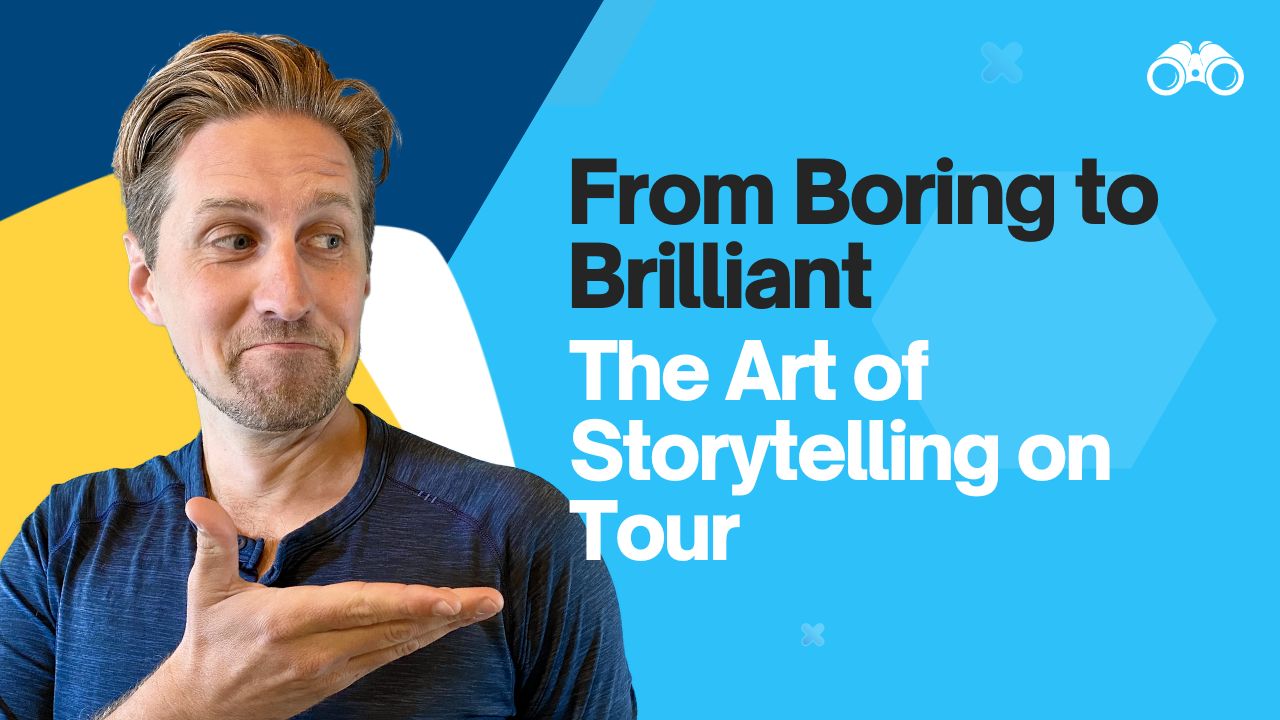From Boring to Brilliant: The Art of Storytelling on Tour
This is the fourth in our Tour Design series. Be sure to watch the whole series here!
Tour guides across Venice, Paris, and New York share a common mistake: backing up a truckload of facts and dumping them over their guests for hours. With smartphones putting endless information at our fingertips, pure facts no longer create the memorable experiences your guests crave.
In today’s world of information overload, where AI and the internet make facts instantly accessible, the true value of your tour lies in how you curate and deliver that information.
Why Stories Matter in Tour Operations
As tour operators, we’re not just information providers – we’re experience curators, carefully selecting what to share and how to share it. This is where the power of storytelling becomes your greatest asset. When your content shifts from fact-based to story-based, several positive changes occur in your business:
- More memorable experiences for your guests
- Increased authentic reviews and testimonials
- Stronger word-of-mouth referrals as tours stay memorable longer
- Deeper emotional connections with your brand and team
- Enhanced guide performance as story-based content proves easier to deliver
- Consistent growth in leads, sales, and profit
The Three Essential Elements of Every Great Tour Story
Every captivating tour story needs three core components that work together to create an unforgettable experience:
- Character: Who is this story about? Your character gives guests someone to connect with emotionally.
- Conflict: What challenge, desire, or tension drives your character forward? This creates the hook that keeps your guests engaged.
- Plot: How do events unfold? Your plot shows how that tension ultimately resolves.
The Universal Story Structure
This narrative structure remains remarkably universal, appearing in everything from ancient myths to modern movies. Gustav Freytag, a man famous for both his magnificent mustache and his understanding of narrative, identified five key stages that make stories work:
- Exposition: Set the scene and introduce your character and the initial tension Rising
- Action: Build that tension through challenges and complications
- Climax: Reach the turning point where tension peaks and begins to resolve
- Falling Action: Show the impact and consequences of what happened
- Resolution: Bring everything to a satisfying close that answers your story’s big question
The Big Question: Your Story’s Heart
Every effective story has one central question that hooks your audience’s attention. This question shouldn’t be answered until near the end of your story, during the climax. It’s what keeps your guests engaged and wanting to know more.
The Story Stop Test
Here’s a practical way to test if you’ve got a real story:
Start telling it to someone – a friend, colleague, or even your guests – and stop halfway through.
If they ask “What happened next?” or “How did it end?” – congratulations, you’ve crafted a genuine story. If they simply nod and move on, you’re probably still in fact-sharing territory.
Turning Facts into Stories: The Eiffel Tower Example
Let’s see this transformation in action with a real example:
- Basic Fact: “The Eiffel Tower was built in 1887.”
- Adding Character: “The Eiffel Tower was built in 1887 by Gustav Eiffel.”
- Creating Story: “In the 1880s, Gustav Eiffel became obsessed with building the tallest man-made structure on Earth.”
Notice how each version builds on the last, but only the final version creates genuine intrigue. As you reveal the challenges Eiffel faced, the story becomes even more compelling:
- The tallest structure at the time was only half his proposed height
- He had less than two years to complete construction
- His grant covered only one-sixth of the cost
- The soil was soft and faced constant flooding
- The elevator system terrified him and required untested innovations
The resolution becomes powerful because you’ve built proper tension: Despite facing criticism, ridicule, a worker’s death, strikes, and lawsuits, Gustav Eiffel not only succeeded but finished on time and 6% under his $1.6 million budget.
Finding Your Tour’s Stories
The most compelling tour stories tap into universal human experiences that resonate across cultures and time:
- Achieving dreams against the odds
- Overcoming significant challenges
- Love and loss
- Standing up for beliefs
- Creating lasting legacies
Instead of listing wine-making steps, tell the story of a local vintner’s first failed batch that led to their signature method. Rather than stating architectural facts, share how an eccentric architect persisted despite universal doubt. Don’t just point out a market stall – tell how the current owner’s grandfather started the business with one basket of oranges during hard times.
Common Storytelling Pitfalls to Avoid
- Late Introduction: Establish your big question early – introduce character and conflict in the first two sentences
- Detail Overload: Skip irrelevant details that don’t serve the story’s core narrative
- Rushed Resolution: Build proper tension before reaching the climax
- Missing Connection: Link your stories to something tangible – what can guests see, touch, or experience right now?
Designing Your Tour’s Story Arc
You have flexibility in how you structure stories within your tour. You might:
- Create one overarching story that resolves at the tour’s end
- Include several shorter stories throughout the experience
- Use stories to replace fact-heavy segments with engaging narratives
The key is ensuring each story serves your tour’s overall purpose while maintaining guest engagement. Remember, your job as a tour or experience designer is to transform information into a journey – and that’s exactly what stories do.
Creating Lasting Impact
Stories create experiences, and experiences create memories. By mastering these storytelling techniques, you’ll craft tours that resonate with guests long after the final stop. This not only drives authentic word-of-mouth marketing but builds the kind of sustainable, profitable tour business that allows you to share your passion with the world in a meaningful way.
Your role as a tour operator extends beyond sharing information – you’re creating memorable experiences that guests will carry with them for years to come. By incorporating effective storytelling techniques into your tours, you’re not just differentiating your business; you’re creating the kind of authentic, engaging experiences that naturally lead to business growth and success.




